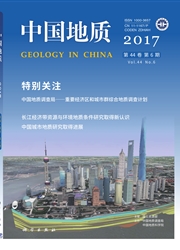

 中文摘要:
中文摘要:
新疆尼勒克县加曼特金矿床产于下石炭统大哈拉军山组的-套中酸性火山岩中.矿体受火山-次火山机构控制,呈脉状、透镜状产出。流体包裹体岩相学、显微测温及激光拉曼显微探针分析表明:流体包裹体为气液两相或纯液相的水溶液,属NaCl-HzO体系;均-温度主要集中在180-260℃,盐度为在(0.2-12.5)wt%NaCl.eqv,密度为0.4-~0.97g/cm。,表现为低温、低盐度、低密度的特点。因此,加曼特金矿的矿床地质和成矿流体特征总体属于中低温热液脉状矿床,可能属于斑岩型与浅成低温热液型之间的过渡型。
 英文摘要:
英文摘要:
The Jiamante gold deposit in Nilka County of Xinjiang is hosted in a suite of intermediate-acidic lavas and pyrodastic rocks of the Lower Carboniferous Dahalajunshan Formation, and is controlled by a volcanic edifice, with ore bodies being in vein-like and lenticular forms. The ore minerals include chalcopyrite, galena, sphalerite, pyrite, limonite, stibnite, covellite, native gold and native silver, whereas the gangue minerals consist mainly of quartz, calcite, sericite and kaolinite. Ores assume euhedral and subhedral granular, emulsive, metasomadc and cataclastic textures. Colloidal, crustiform, comb, brecciated, banded and massive structures are commonly observed. Petrographic observation, microthermometric measurement and Laser P,.aman Spectrometry reveal that fluid inclusions in sphalerite and quartz are mainly two-phase and pure liquid phase aqueous ones, belonging to the NaC1-H20 system, and the homogeneous temperatures range from 180 to 260 ~C, with the salinities being 0.2-12.5 wt% NaCl.eqv, and the densities from 0.49 g/cm3 to 0.97 g/cm3. All these data show that ore-forming fluids are characterized by low temperature, low salinity and low density. Thus, the characteristics of ore-forming fluid system and ore geology of the Jiamante gold deposit suggest that the ore deposit is of the mesothermal to epithermal lode type, representing a transition from porphyry to epithermal mineralization.
 同期刊论文项目
同期刊论文项目
 同项目期刊论文
同项目期刊论文
 期刊信息
期刊信息
